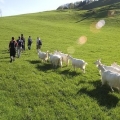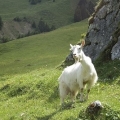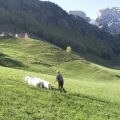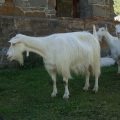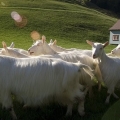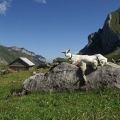Appenzell Keçisi

Appenzell Keçi Irkı-İsviçre'nin sarp arazi koşullarında yaşayan bir keçi ırkıdır. İsviçre Keçi Irklarından sütçü bir keçi ırkıdır. Görünüşü Saanen Keçisini andırır. Saanenlere göre kılları uzun,vücut daha geniştir. Saanen keçiye göre daha küçük keçilerdir. Vücut beyaz kıllarla kaplıdır.

Appenzel Keçisinin bacakları güçlü olup, zorlu dağa koşullarına son derece uyumlu keçilerdir. Son derece güzel görünüşlü bir keçi ırkıdır. Güçlü bir vücut yapısına sahiptir.
Verim Özellikleri
Laktasyon Süt Verimi 700-800 Kg
Laktasyon Süresi 270 gün
Süt Yağ Oranı %2.9
Sütteki Protein Oranı %2.7
Canlı Ağırlığı Erkeklerde 65 Kg
Canlı Ağırlığı Dişilerde 45 Kg
Vüçut Yüksekliği Erkeklerde 75-85 cm
Vücut Yüksekliği Dişilerde 70-80 cm

Appenzell Goat
Appearance: The Appenzell Goat is a pure white goat with mid-length hair. It has a powerful, harmoniously built body. The limbs are powerful and well positioned. The body is somewhat broader than that of the Saanen and therefore somewhat smaller. This goat is bred hornless. The height of the whithers is said to be 75 to 85 cm with bucks, and 70 to 80 cm with the nannies. The male animals are on average 65 kg in weight, and the female approx. 45 kg.
Distribution: The Appenzell Goat is found above all in both cantons Appenzell and St. Gallen (Toggenburg). In canton Zurich only the Zurich Goat is bred (today only very little!). It is a cross between the Appenzell and the Saanen.
Characteristics: In milk production the Appenzell Goat is on par with the other breeds: during lactation between 700 and 800 kg, fat 2.9%, protein 2,7%, lactation duration 270 days. As is generally known, milk production is heavily influenced by care. The number of herd book animals is around 800; the stock is slowly increasing again. This breed was very heavily affected by the CAE-Virus, so that extensive restoration had to be done. Today the breed is essentially CAE-free.
Breeding Book: The breed is officially recognized. The breeding books are kept by breeding associations and the herd book by the small animal center.

Reference:
Endangered Domestic Animal Breeds 1995, Pro Specie Rara, Engelgasse 12a, CH-9000 St. Gallen, Switzerland, Telefon xx41/(0)71/222 74 20, Fax xx41/(0)71/223 74 01. German Translation provided by John te Velde, Associate Professor of German, Oklahoma State University
Photographs:
Michael von Luttwitz, Max-Friesenegger-Str. 22, D-86899 Landsberg, Germany
